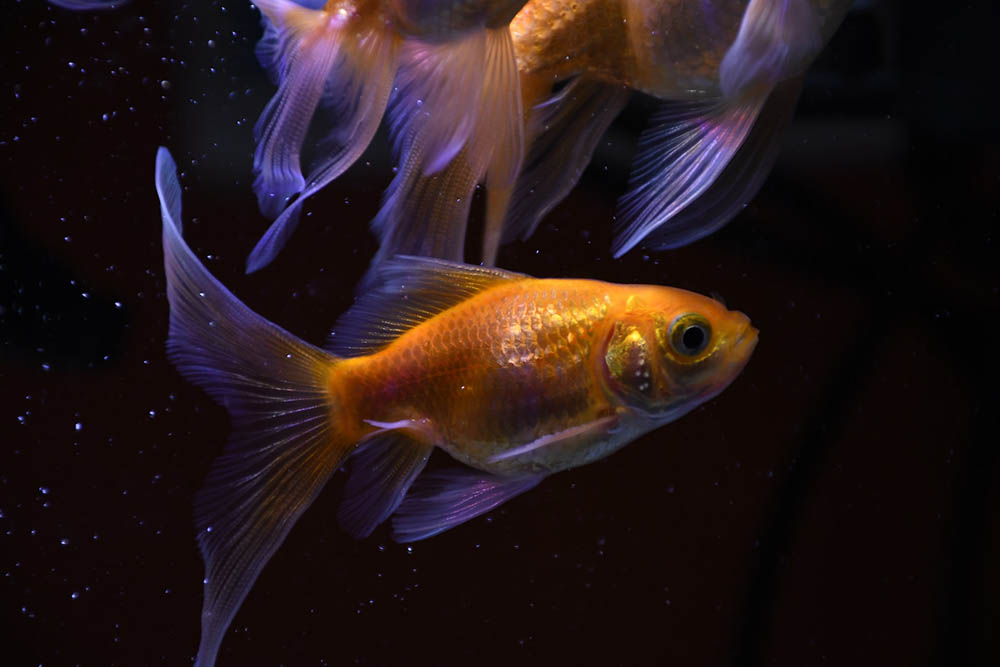Goldfish Hole in the Head Disease: Causes, Symptoms & Treatment

Updated on

If you’ve recently taken in a goldfish that was kept in poor conditions, or if you’re new to fish keeping and unknowingly haven’t kept up your water quality, you may have noticed sores on your goldfish’s head. Over time, these sores may open, leading to visibly pitting sores on your goldfish’s head. If you’ve noticed sores on your goldfish’s head, here are the things you need to know about Hole in the Head disease.

What is Hole in the Head Disease?
Hole in the Head disease is caused by parasitic protozoans called Hexamita and the disease is less commonly called Hexamitiasis. These parasites often naturally exist within the gastrointestinal tract of fish, but when the fish’s immune system is weakened for some reason, it gives the parasite a chance to take hold throughout the fish’s body. The parasites will spread into the fish’s organs, eventually leading to failure of organs and visible sores. Hole in the Head disease is deadly but treatable.

What Causes Hole in the Head Disease?
Hole in the Head disease is believed to be caused by a suppressed immune system in your goldfish. This can be caused by stress, poor water quality, malnutrition, overcrowding, or poor response to travel or shipping. This disease is common in fish farms and fish like angelfish, discus, Oscars, and cichlids seem to be at higher risk than other fish kept as pets, but any fish can get Hole in the Head disease.
Goldfish kept in an unhygienic environment are at a high risk for developing Hole in the Head disease, as well as those that have a nutritionally inadequate diet. This dietary inadequacy can either be related to significant underfeeding or to poor nutrition from expired or low-quality fish food. Even though we’re not really used to it, goldfish require a varied, nutritionally complete diet that they are not able to get just from pellets or other commercial goldfish food. They are healthiest and happiest when their diet is supplemented with edible plants, like duckweed and herbs, and with high-protein live or frozen foods.
What are the Symptoms of Hole in the Head Disease?
The most noticeable symptom of Hole in the Head disease is visible pimple-like sores on the fish’s head that eventually lead to pitted, open sores that look like a hole in the fish’s head. On rare occasions, you may be able to see the protozoans in the wound with the naked eye, but they are extremely small, and it is unlikely you will notice this symptom. Since Hexamitiasis starts in the GI tract, another noticeable symptom is that your goldfish may develop long, stringy, white poop. This may start even before you notice any sores on your fish.
If you suspect your fish is sick and want to ensure you provide the right treatment, we recommend that you check out our best-selling and comprehensive book The Truth About Goldfish on Amazon today. It has entire chapters dedicated to in-depth diagnoses, treatment options, a treatment index, and a list of everything in our fishkeeping medicine cabinet, natural and commercial (and more!)
How Do I Treat Hole in the Head Disease?
Hexamitiasis is most commonly treated with a medication called metronidazole. It works best when added to the fish’s food, which can be accomplished by soaking the food in medicated tank water and then allowing it to dry out before feeding. The easiest way to medicate food is to mix the medication into gel food mix. There are varieties of this medication that can be added directly to the tank as well. Quinine Sulfate is another medication that is less commonly used and is mainly effective at treating external Hexamitiasis and usually does not work well for the internal infection.
How Do I Prevent Hole in the Head Disease?
Prevention is your best bet against Hole in the Head disease. Maintaining water quality and keeping a stress-free home for your goldfish is your best prevention. Maintaining water quality is especially important if you are keeping an overstocked tank. Overstocked tanks are at an increased risk for poor water quality and disease, as can be seen by the prevalence of Hexamitiasis in fish farms.
Also, make sure to feed your goldfish a high-quality, varied diet. Pellets and flakes often are not ideal as a singular food source. Many fruits and veggies are goldfish safe and combining high-quality flakes or pellets with gel food and treat food, like bloodworms, can create a healthy and varied diet for your goldfish.
In Conclusion
Hole in the Head disease can be deadly to your goldfish if not caught early, so make sure you are routinely giving your goldfish a thorough look-over to check for any sores or parasites. Don’t treat your fish or your tank unless you’re sure of what you’re treating for, as unnecessary medications can cause additional stress on your fish. Keeping a healthy tank will help prevent Hole in the Head disease, giving your goldfish the best chance. If you do have a goldfish with Hole in the Head disease, you know where to start when it comes to treatment!
See Also:
- How to Treat Swim Bladder Disease in Goldfish (Vet Answer)
- 6 Common Goldfish Diseases: Our Vet Explains Treatment & Prevention
Featured Photo Credit: Pavaphon Supanantananont, Shutterstock












